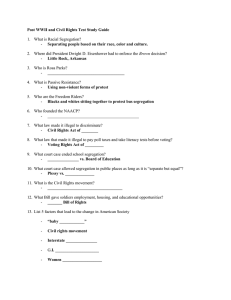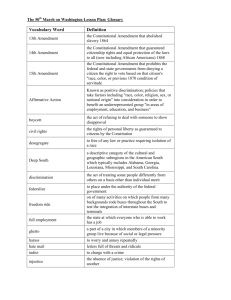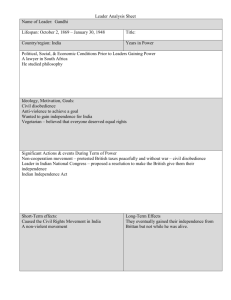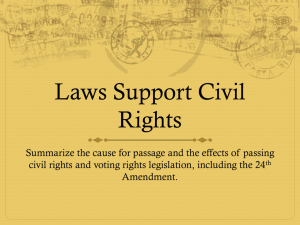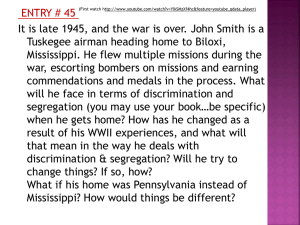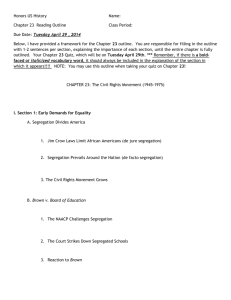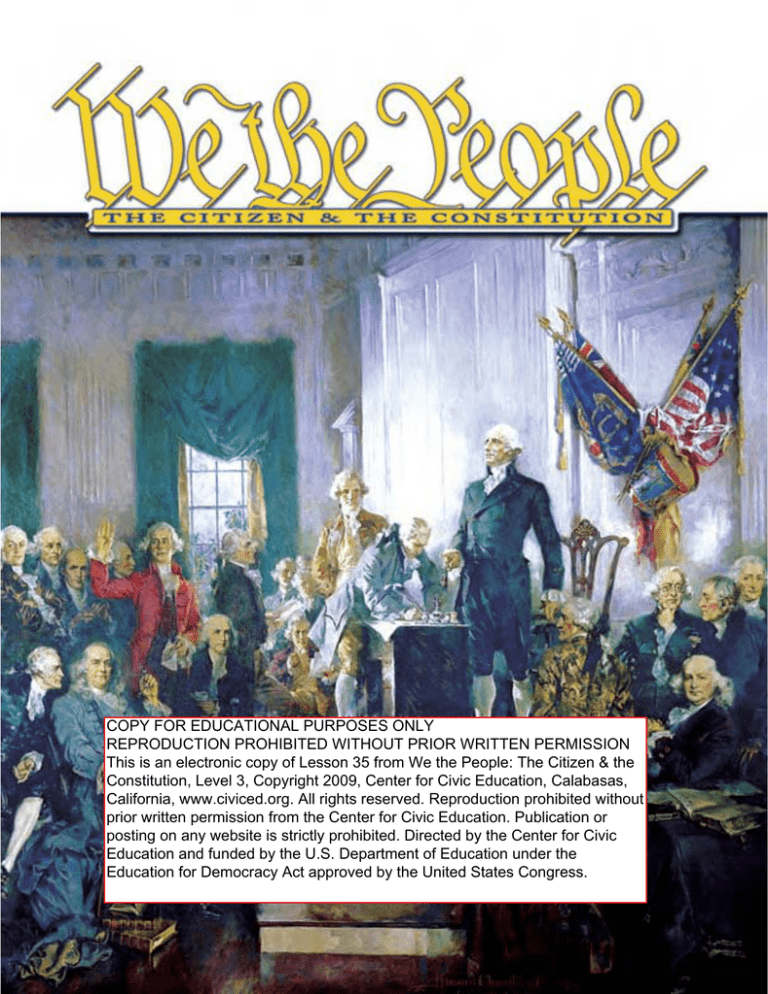
COPY FOR EDUCATIONAL PURPOSES ONLY
REPRODUCTION PROHIBITED WITHOUT PRIOR WRITTEN PERMISSION
This is an electronic copy of Lesson 35 from We the People: The Citizen & the
Constitution, Level 3, Copyright 2009, Center for Civic Education, Calabasas,
California, www.civiced.org. All rights reserved. Reproduction prohibited without
prior written permission from the Center for Civic Education. Publication or
posting on any website is strictly prohibited. Directed by the Center for Civic
Education and funded by the U.S. Department of Education under the
Education for Democracy Act approved by the United States Congress.
35
HOW HAVE CIVIL RIGHTS
MOVEMENTS RESULTED IN
FUNDAMENTAL POLITICAL
AND SOCIAL CHANGE IN
THE UNITED STATES ?
LESSON PURPOSE
The Declaration of Independence is celebrated for its commitment to the principles of human liberty and
equality. The Fourteenth Amendment guarantees equal treatment under the law. This lesson focuses on political
and social movements that have used and continue to use the Declaration and the Fourteenth Amendment to
effect fundamental political and social change in the United States.
When you have finished this lesson, you should be able to explain why African Americans, women, and other
groups found it necessary to take concerted action to ensure recognition of their civil rights. You should be able
to describe some of the goals and tactics that civil rights movements have used. You should be able to describe and
explain the importance of the Civil Rights Act of 1964 and the Voting Rights Act of 1965. You also should be able
to identify some ongoing issues involving civil rights. Finally, you should be able to evaluate, take, and defend
positions on landmark legislation involving civil rights and the role of civil disobedience in America’s constitutional democracy.
TERMS AND CONCEPTS TO UNDERSTAND
civil disobedience
civil rights
de facto segregation
de jure segregation
261
WHAT WAS THE STATUS OF CIVIL RIGHTS
IN MID-TWENTIETH CENTURY AMERICA?
Discrimination in the United States has affected
African Americans and other groups, including Native
Americans, Hispanic Americans, Asian Americans,
women, and members of religious minorities.
Discrimination based on race has its roots in racial separation, known as segregation. There are two kinds of
segregation:
앬
De jure segregation refers to separation
required by law. For example, before the
Supreme Court’s 1954 decision in Brown v.
Board of Education several states had laws
requiring school districts to maintain separate schools for white and nonwhite students.
These laws always affected African Americans
but sometimes affected other racial minorities as well, including Asian Americans.
앬
De facto segregation refers to racial separation caused by the actions of private individuals and groups. For example, before passage
of the Civil Rights Act of 1964 (discussed
later in this lesson) some restaurants, hotels,
and theaters served only white customers.
Some landlords refused to rent houses, apartments, or businesses to racial minorities.
The Brown decision addressed only de jure segregation in public schools. However, that decision clearly
implied that all laws compelling separation of the races
violate the guarantee of equal protection of the laws.
When little was done to implement the Brown decision,
the NAACP brought a follow-up case. In Brown II (1955)
the Supreme Court authorized federal district courts to
issue such orders “as are necessary and proper to admit to
public schools on a racially nondiscriminatory basis with
all deliberate speed the parties to these cases.”
Some school districts found ways to implement the
Brown decisions. But in some parts of the country the
decisions were extremely unpopular. To understand
why, it is necessary to recall that slavery was legal in
America for almost 250 years, from 1619 to 1865. After
the Civil War and Reconstruction the Jim Crow system
maintained racial separation for more than a half century.
Soldiers in the U.S. Army were segregated by race until
after the end of World War II. The army was officially
desegregated in 1948 by an executive order of President
Harry Truman.
Still, in the 1950s racial segregation and discrimination
were deeply entrenched. African Americans and other nonwhites were treated as second-class citizens. A web of state
laws and local ordinances mandated de jure segregation in
almost every aspect of public life, including schools, streetcars and buses, toilets, and drinking fountains. In some
What democratic principles are violated by de jure and de facto segregation?
262
places the courts kept separate Bibles for administering
oaths to whites and nonwhites, prisoners were segregated
based on race, and laws prevented interracial marriage.
Such discrimination was not limited to the South, but
Southern leaders promised “massive resistance” to the
Brown decisions. Some states refused to desegregate
their schools and waged legal battles to maintain segregation. Other states passed laws making it possible for
white students to attend private schools with state financial support. Some school districts closed their schools
altogether rather than desegregate.
For the most part the national government deferred to
state governments in matters of race. The Ku Klux Klan,
an organization created after the Civil War to advocate
the supremacy of the white race, was reconstituted and
revitalized in 1955. The next several years saw an increase
in racially motivated murders, assaults, death threats,
cross burnings, and attacks on private homes. President
Dwight Eisenhower, who had been reluctant to intervene
in state matters, finally sent National Guard troops into
Little Rock, Arkansas, in 1957 to open public schools that
had been closed in protest to Brown and to enforce order.
WHAT DO YOU THINK?
�
Is de facto segregation more difficult
to change than de jure segregation?
Why or why not?
�
Does de facto segregation occur today
based on race, ethnicity, gender, or
other characteristics? Explain.
�
Is there ever such thing as permissible
segregation? Why or why not?
WHAT WERE THE ORIGINS OF THE MODERN
CIVIL RIGHTS MOVEMENT FOR AFRICAN
AMERICANS AND WHAT WERE ITS GOALS?
African Americans, leaders and ordinary men and
women alike, challenged and resisted Jim Crow laws from
the beginning. They had organized cooperative associations to assert community economic rights, and they had
armed themselves against violence from the Klan and
other white-supremacy organizations. In segregated public schools they had taught and learned black history.
Their religious, social, and political associations had nurtured networks of communication and resistance by the
time the Supreme Court issued the Brown decision.
Organizations such as the NAACP, founded in 1909,
helped keep civil rights issues on the national agenda
after Brown. The NAACP was joined by several religious
What are the principles of nonviolent direct action as practiced by
Mohandas Gandhi and leading organizations of the civil rights
movement?
organizations, including the Alabama Christian
Movement for Human Rights, the Southern Christian
Leadership Council, and the Fellowship of Reconciliation,
an interfaith organization founded in 1914 to promote
peace and justice. Many civil rights leaders also were
influenced by principles of nonviolent direct action used
by the Indian leader Mohandas Gandhi, commonly
known as Mahatma Gandhi, in winning independence
for India from Great Britain in 1947. Nonviolent direct
action sometimes included civil disobedience, or the
open violation of unjust laws together with a willingness
to accept the consequences of violating those laws.
Preparation and education were central to the civil
rights campaigns of the 1950s and 1960s. Many civil
rights participants were trained in political organization
and nonviolent social action at the Highlander Folk
School in Tennessee. After petitioning local, state, and
national leaders to repeal laws allowing racial segregation and discrimination, leaders organized direct
actions, including sit-ins at restaurants and other public
facilities, protests, marches, boycotts, and demonstrations. They were met with hostility and often violence.
In December 1955 as part of a planned protest,
NAACP member and chapter secretary Rosa Parks
refused to give up her seat to a white man on a city bus
in Montgomery, Alabama. She was arrested for violating
an ordinance requiring segregated seating on public
transportation. The NAACP used Parks’s case to test the
constitutionality of the ordinance and called for a
263
WHAT IS THE CIVIL RIGHTS ACT?
In the spring of 1963 civil rights leaders organized
public demonstrations throughout the South in which
young people often were prominent. Some protests were
met with violence. In Birmingham, Alabama, local
police used powerful fire hoses and dogs to break up
marches. Television cameras captured scenes of confrontations, and newspapers around the world carried
pictures and stories. These images aroused sympathy
and outrage throughout the United States.
What were the results of the refusal of Rosa Parks to give up her seat
to a white man on a city bus in Montgomery, Alabama in 1955?
boycott of the Montgomery bus system. Martin Luther
King Jr., a young minister in Montgomery, helped lead
the year-long boycott, which ended when the Supreme
Court ordered Montgomery city officials to end segregation on city buses.
Civil rights activists also worked for passage of laws to
protect their right to vote. King, like Gandhi, an advocate of nonviolent direct action, believed that the Brown
decision could be implemented “without rancor or bitterness” if everyone had access to the ballot.
In August that same year more than two hundred
thousand people, mostly African Americans, converged
on Washington, D.C., to demonstrate for a full and
speedy program of civil rights and job opportunities.
President John F. Kennedy announced that he would ask
Congress to enact major new civil rights legislation.
Kennedy was assassinated three months later. The task of
pushing for the legislation fell to his successor, Lyndon
B. Johnson. Congress passed the Civil Rights Act of
1964, using its constitutional power under Article I to
regulate interstate commerce so that it could regulate
private activities as well as state action. The act remains
the most far-reaching civil rights legislation in American
history, outlawing both de jure and de facto segregation
and many forms of discrimination. The central provisions of the act
앬
Outlaw discrimination in hotels, restaurants,
theaters, gas stations, airline terminals, and
other places of public accommodation
WHAT DO YOU THINK?
�
�
264
Explain the importance of the following for
civil rights movements to succeed today:
앬
Support of religious groups
앬
Leadership and organization
앬
Preparation
앬
Public education
앬
Patience
앬
Links to principles in the
Declaration of Independence
or the Constitution
What factors would influence your decision
to organize, join, or support a civil rights
movement today? What factors would influence
your decision to refrain from joining such
a movement?
What events led to President Johnson signing the Voting Rights Act
of 1965?
Why was the Voting Rights Act of 1965 needed to enforce the provisions of the Fifteenth Amendment?
앬
Give the national government additional
authority to end school desegregation
앬
Prohibit job discrimination by businesses
and labor unions
앬
Authorize the United States Justice Department to file lawsuits against states that discriminate against women and minorities
When President George W. Bush signed the 2006
extension of the Voting Rights Act, he acknowledged
both progress in the area of civil rights and the need for
continued efforts:
“
WHAT IS THE VOTING RIGHTS ACT?
The Civil Rights Act did not address problems that
minorities encountered when they tried to vote. In March
1965 civil rights protesters met in Selma, Alabama, to
march from there to Montgomery to protest voting discrimination. Alabama’s governor sent state troopers to
stop the march. Several demonstrators were clubbed and
beaten. One was killed. The event was covered on national television. Five days later President Johnson announced
that he would send Congress a voting rights bill. Using its
authority to enforce the provisions of the Fifteenth
Amendment, Congress quickly passed the Voting Rights
Act of 1965. Amended several times since its passage and
extended to 2031, the Voting Rights Act now
앬
Prohibits discrimination based on race
앬
Eliminates literacy tests, poll taxes, and
discriminatory registration practices
앬
앬
Requires states, counties, and cities with
significant numbers of voters who do not
speak English to provide voting materials
and assistance in appropriate languages
Requires states and counties with a history
of discrimination to be monitored by the
Justice Department
In four decades since the Voting Rights Act
was first passed, we’ve made progress toward
equality, yet the work for a more perfect
union is never ending. We’ll continue to
build on the legal equality won by the civil
rights movement to help ensure that every
person enjoys the opportunity that this
great land of liberty offers.
CRITICAL THINKING EXERCISE
Examining the Civil Rights and Voting Rights Acts
Work in one of two groups. One group should obtain
a copy of the Civil Rights Act (1964) and all amendments
to it. The other group should obtain a copy of the Voting
Rights Act (1965) and all amendments to it.
First, each group should review the criteria for landmark legislation in Lesson 22. Then each group should
study its statute and amendments and do any additional
research to enable the group to respond to the following
questions. Finally, each group should share its responses
with the class as a whole.
�
Does the statute you examined qualify as landmark legislation? Explain your reasoning.
�
What are the significant features of amendments
to the statute your group examined? Why were
they added?
�
Have there been obstacles to implementing the
statute or its amendments? If so, explain what
they have been and what has been done to overcome them.
265
WHAT IS THE ROLE OF CIVIL DISOBEDIENCE
AS A FORM OF POLITICAL PARTICIPATION?
Participants in the struggles against slavery, the
woman suffrage movement, and the civil rights movement all used civil disobedience to advocate change.
They did so only after the use of their First Amendment
rights of petition, free speech, and assembly proved
futile. In his “Letter from Birmingham City Jail” Martin
Luther King Jr. wrote,
“
I submit that an individual who breaks a law
that his conscience tells him is unjust, and
willingly accepts the penalty by staying in jail
to arouse the conscience of the community
over its injustice, is in reality expressing
the very highest respect for the law.
King’s words echoed those of American philosopher
Henry David Thoreau (1817–1862), who in 1849 set forth
some of the basic ideas about civil disobedience in his
essay “On the Duty of Civil Disobedience.” Thoreau
argued that individuals should obey their conscience.
When conscience and law conflict, individuals have a
moral responsibility to promote justice by disobeying the
law. Thoreau and others who have written about civil disobedience, such as Russian novelist Leo Tolstoy and India’s
Gandhi, agree that civil disobedience must be nonviolent
and that those who participate in civil disobedience must
be willing to identify themselves and accept legal sanctions. Civil disobedience does not attempt rebellion or
revolution. But it does put conscience above the law.
Defenders of civil disobedience counter that, in fact,
there can be no other final judge of obedience to law than
individual conscience. Each person must make his or her
own decision whether to obey particular laws. After all, the
defenders contend, laws are not necessarily just. They can
be unjust. Defenders therefore argue that there are higher
moral laws than the laws of any state, however democratic
and constitutional. These higher laws shape the moral conscience of individuals. An unjust social situation breeds disorder. Seeking a more just society through civil disobedience may promote order rather than undermine it.
WHAT DO YOU THINK?
�
Under what circumstances, if any, do you
think a citizen in a representative democracy
has the right to engage in civil disobedience?
Explain your position.
�
Read Martin Luther King Jr.’s “Letter from Birmingham City Jail.” How might King respond
to the charge that those who followed their
consciences to defy local segregation laws were
no different from white protesters who defied
court orders to integrate?
Justification for this viewpoint has ancient roots.
Antigone, the title character and tragic heroine of the
Greek playwright Sophocles’ drama, justified disobedience
to royal authority in the name of law higher than civil
authority. For Sophocles (c. 496–406 BC) that higher law
was an objective morality rooted in law made by the gods,
not by human beings, as Antigone defies the tyrant Creon
to secure a respectable funeral for her brother.
Critics argue that civil disobedience is never justified because it is an attack on constitutional democracy. American democracy’s legal system, they argue,
often has protected minority rights in the face of
majority oppression, as in Brown v. Board of
Education and in many other instances. They add that
when democratic decisions appear to go amiss, they
can be challenged in court. American constitutional
democracy does not leave fundamental individual
rights at the mercy of majorities. The practice of civil
disobedience makes individual conscience absolute,
the final judge of obedience or disobedience. Thus it
weakens respect for law and is an invitation to social
chaos, a state of gross disorder where no rights or values are safe.
266
Should people be allowed to demonstrate by holding sit-ins in public
buildings? Why or why not?
What civic purposes are served by public demonstrations?
HOW HAS THE MOVEMENT
FOR CIVIL RIGHTS CHANGED SINCE
THE MID-TWENTIETH CENTURY?
앬
Farm workers In the early 1950s Mexican
American Cesar Chavez began to register
minority voters and to organize farm
workers to demand better conditions in
the fields of California. He and Dolores
Huerta later founded the United Farm
Workers Union. It and similar organizations have lobbied Congress for better
pay and working conditions for farm
workers, organized consumer boycotts of
farm products such as grapes and lettuce,
challenged the hiring of illegal aliens during
farm-worker strikes, and protested
the use of dangerous pesticides.
앬
Native Americans In 1968 several hundred
members of Native American tribes met to
discuss issues affecting their communities.
Conversations focused on substandard
housing, an eighty percent unemployment
rate, discrimination in education and other
areas, and claims of police brutality. The
American Indian Movement (AIM) emerged
out of this meeting. AIM gained national
and international attention in the 1970s
when some of its members seized the headquarters of the Bureau of Indian Affairs
in Washington, D.C., and participated in
standoffs with public authorities at Wounded
Knee and Pine Ridge, South Dakota, in
The Civil Rights and Voting Rights Acts were major
legal achievements of the civil rights movement of the
1950s and 1960s. Unfortunately King was assassinated in
1968 while helping to organize a protest supporting sanitation workers in Memphis, Tennessee, who needed better pay and working conditions. His murder led to riots in
cities throughout the United States. Other riots occurred
in American cities during the 1960s protesting perceived
economic discrimination and alleged police brutality.
After passage of the laws in the 1960s organizations
such as the NAACP turned their attention to other issues
affecting minorities and the poor, including
앬
Voter registration
앬
Laws increasing the minimum wage
앬
Better health care for people with HIV/AIDS
앬
Health services for minority populations
in urban and rural areas
앬
High-quality public education
for all minority children
Other groups also have been active in pursuing rights
for their members and other minorities. The following
are merely three examples:
267
disputes over land and mineral rights.
Today AIM’s focus includes cultural renewal,
monitoring police treatment of Native
Americans, opposing the use of Native
American caricatures as mascots for sports
teams, such as the Atlanta Braves and Florida
State University Seminoles, and creating
employment programs for Native Americans.
AIM also supports the efforts of indigenous
groups outside the United States.
앬
Women Women worked for generations
to win the right to vote, which they achieved
through the Nineteenth Amendment, ratified
in 1920. In the 1960s and 1970s women’s
organizations turned their attention to issues
such as reproductive rights, equal pay for
equal work, and harassment in the workplace. The National Organization for
Women, formed in 1966, lobbied for the
Equal Rights Amendment (ERA), which
Congress submitted to the states in 1972. The
proposed amendment provided that
“
principles in the Declaration of Independence and the Constitution?
�
What role does public education play
in the movement?
�
Has the movement used civil disobedience
or supported civil disobedience to achieve
its goals? Why or why not?
REVIEWING AND USING THE LESSON
�
What is the difference between de jure
and de facto segregation?
�
Why has the Civil Rights Act of 1964 been
called the most far-reaching civil rights
legislation in American history?
�
Why was it necessary to extend the
Voting Rights Act of 1965 in 2006?
�
How is civil disobedience different
from merely breaking the law?
Equality of rights under the law shall
not be denied or abridged by the United
States or any State on account of sex.
Only thirty-five of the required thirty-eight states ratified the ERA. Although the amendment failed, Congress
has passed laws that achieve some of the goals of the proposed amendment, such as the Pregnancy Discrimination
Act, making it unlawful to fire, not hire, or otherwise discriminate against a woman because of pregnancy or
intent to become pregnant, and the Equal Credit
Opportunity Act, making it unlawful to discriminate on
the basis of gender or marital status in making loans. The
Supreme Court also has held that sexual harassment is a
form of illegal discrimination (Meritor Savings Bank v.
Vinson, 1986). Legislative and judicial triumphs have led
some to believe that the ERA is not necessary.
CRITICAL THINKING EXERCISE
Evaluating Contemporary Civil Rights Movements
Work in one of three groups. Each group should
select a contemporary civil rights movement and then
respond to the following questions. The groups should
compare responses.
�
How is the movement you studied
organized? Who are its leaders?
�
What are the stated objectives of the movement? How are those objectives related to
What changes have been made due to the movement for women’s rights?
268

